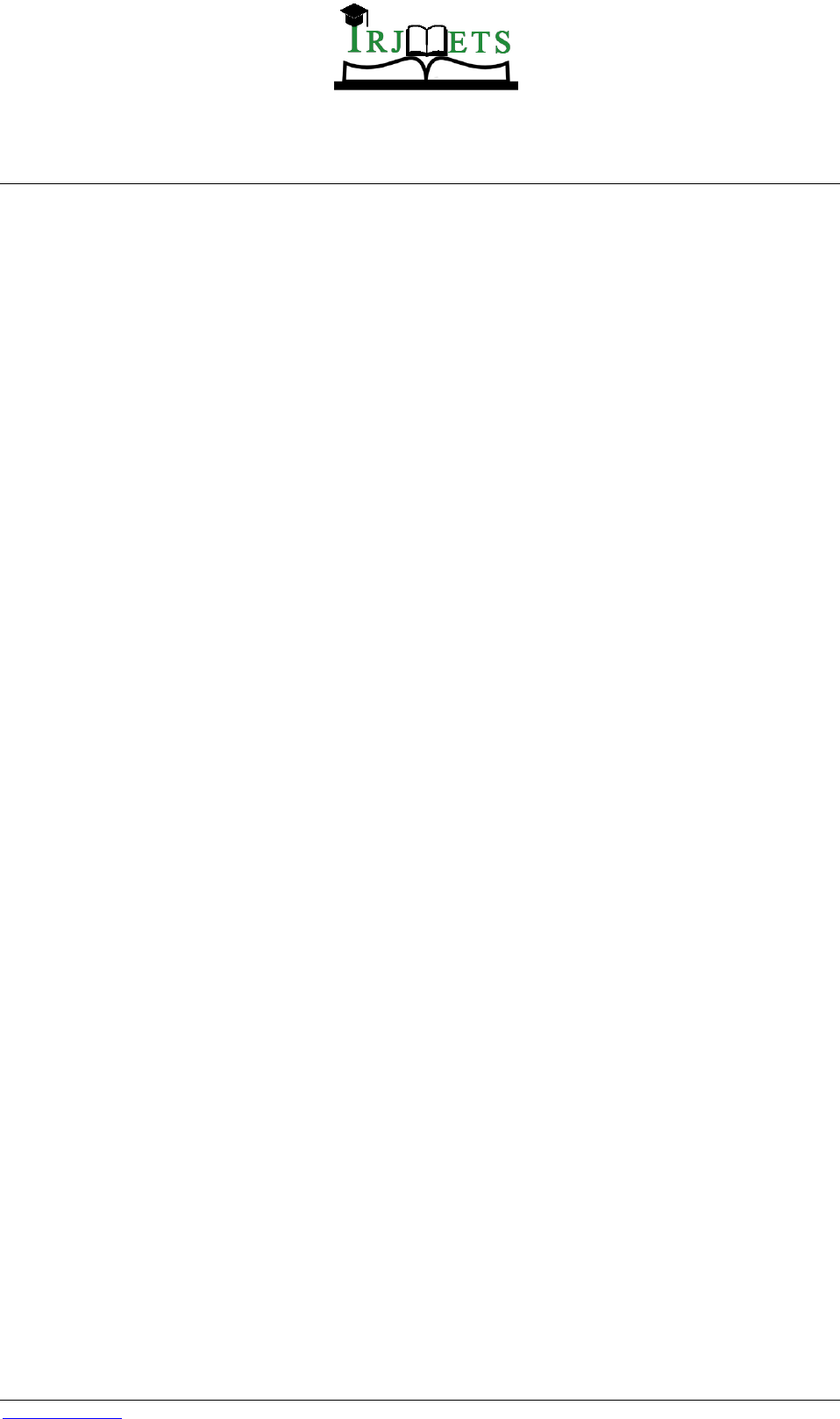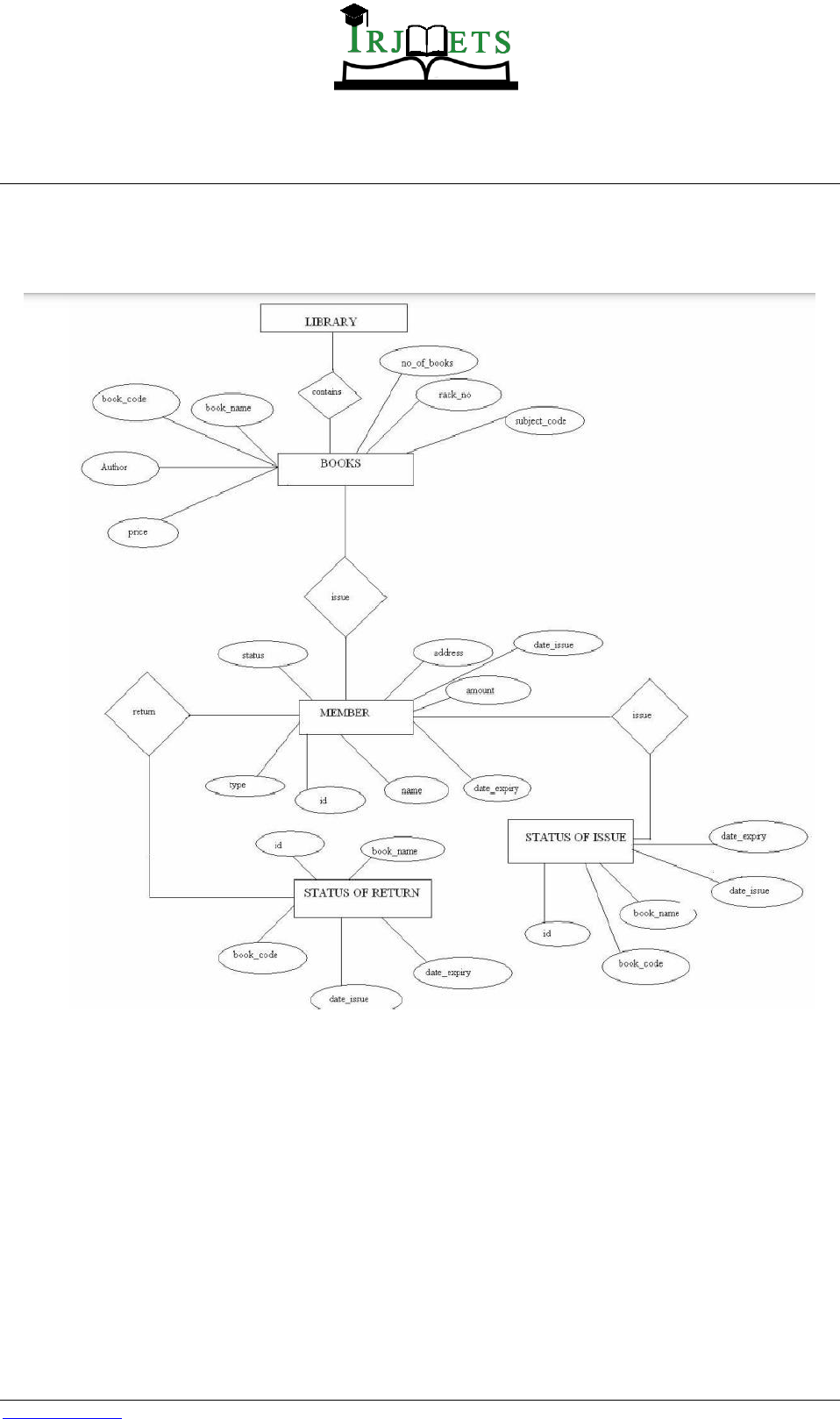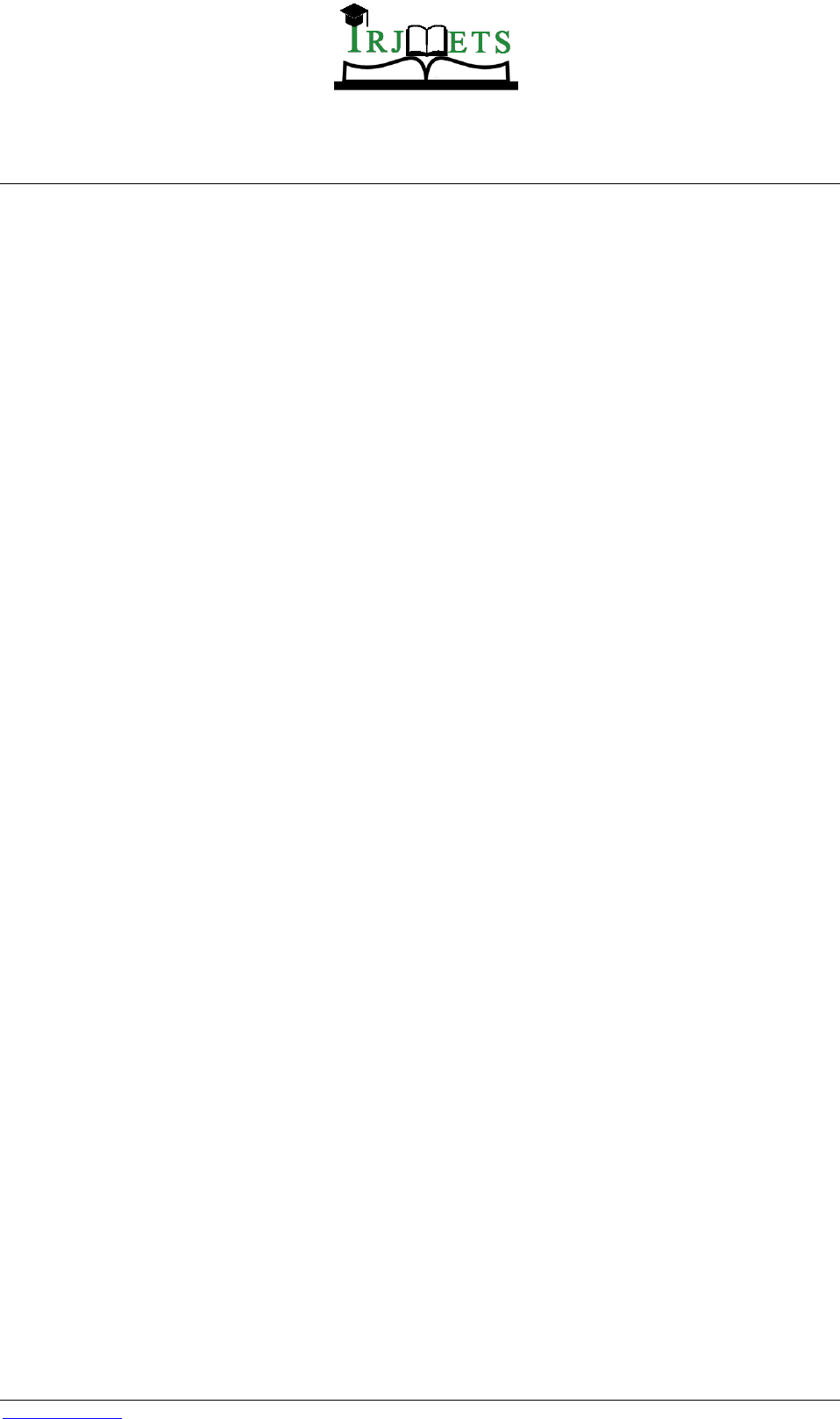
e-ISSN: 2582-5208
International Research Journal of Modernization in Engineering Technology and Science
( Peer-Reviewed, Open Access, Fully Refereed International Journal )
Volume:05/Issue:03/March-2023 Impact Factor- 7.868 www.irjmets.com
www.irjmets.com @International Research Journal of Modernization in Engineering, Technology and Science
[1633]
STREAMLINING LIBRARY MANAGEMENT SYSTEM: AN
IMPLEMENTATION USING JAVA AND SQL
Pratik Rajendra Pingale
*1
, Ankita Uday Manekar
*2
*1,2
S.N.D. College Of Engineering, MBA & Research Centre, Babhulgaon, Yeola 423401
Maharashtra, India.
DOI : https://www.doi.org/10.56726/IRJMETS34487
ABSTRACT
The Library Management System project is a computerized system that aims to streamline the daily operations
of a library. This project is developed using Java and SQL technologies, providing a scalable and robust platform
for managing a library's resources. The system allows library staff to add new members, new books, issue and
return books, and generate reports with ease. The use of a computerized system reduces manual efforts and
provides accurate and up-to-date information on books, members, and transactions. The modular design of the
system allows for easy customization and expansion to meet the evolving needs of libraries.
Keywords: Library Management System, Java, SQL, ER Diagram, Computerized System, Scalability, Modularity,
Customization, Daily Operations.
I. INTRODUCTION
Libraries play a crucial role in the dissemination of knowledge and information in the society. The library
resources, including books, journals, and other materials, are valuable assets that need to be managed
efficiently. With the advent of technology, library management has become more sophisticated, and libraries
are increasingly adopting modern library management systems (LMS) to manage their resources and activities.
Virtuoso SoftTech, an IT services division of VPEL, recognizes the importance of efficient library management
and the role it plays in enhancing the user experience. Virtuoso SoftTech's current library management system
is outdated and manual, which makes it inefficient, time-consuming, and prone to errors. There is a need to
upgrade the current system to a modern and automated system that can provide real-time information about
the library resources and activities.
The library management system developed using Java and SQL will automate the library management process
and reduce the workload of the librarians. It will provide easy access to the library resources and online
databases, enhancing the user experience. The system will also improve the security and accuracy of the library
management process, ensuring that the library resources are managed efficiently.
This research paper aims to design and develop a library management system using Java and SQL for Virtuoso
SoftTech. The paper will present the requirements gathering process, system design, development, testing, and
deployment of the library management system. The paper will also highlight the features of the system,
including book management, patron management, circulation management, inventory management, and
reporting.
Overall, the library management system developed using Java and SQL for Virtuoso SoftTech will be a valuable
asset that will enhance the library's efficiency and improve the user experience. The system will provide
accurate and up-to-date information about the library resources and activities, making it easier for the
librarians to manage the library. The system can also be customized to meet the specific needs of Virtuoso
SoftTech, making it a flexible and adaptable solution for efficient library management.
II. RESEARCH METHODOLOGY
The research methodology for developing the Library Management System project for Virtuoso SoftTech
involves the following steps:
Requirements Gathering:
In this phase, we will identify the requirements for the system through discussions with the stakeholders, such
as library staff and management. We will document the functional and non-functional requirements and
prepare a detailed requirements specification.

e-ISSN: 2582-5208
International Research Journal of Modernization in Engineering Technology and Science
( Peer-Reviewed, Open Access, Fully Refereed International Journal )
Volume:05/Issue:03/March-2023 Impact Factor- 7.868 www.irjmets.com
www.irjmets.com @International Research Journal of Modernization in Engineering, Technology and Science
[1634]
System Design:
Once we have the requirements specification, we will design the system architecture and create a design
document. We will use UML diagrams to model the system, including use case diagrams, sequence diagrams,
and class diagrams. We will also finalize the technology stack to be used, which includes Java and SQL.
Development:
In this phase, we will begin coding the system, following the design specifications. We will create a modular and
scalable codebase using the Java programming language and use SQL for the database management system. We
will also perform unit testing and integration testing throughout the development phase to ensure the system
meets the requirements specification.
User Acceptance Testing:
Once the development phase is complete, we will conduct user acceptance testing (UAT) to validate the
system's functionality and usability. The UAT will be carried out by the library staff and management, who will
use the system to perform their daily tasks and provide feedback.
Deployment:
After the UAT phase, we will deploy the system to the production environment. We will ensure that the system
is configured correctly and that all the necessary dependencies are installed.
Maintenance:
Once the system is live, we will provide maintenance and support services to ensure that the system operates
smoothly. We will address any issues that may arise and provide regular updates to the system to ensure it
remains up-to-date with the latest technologies.
The research methodology will follow an iterative and incremental approach, allowing us to refine and improve
the system at each stage of the development process. This approach will ensure that the final product meets the
requirements of Virtuoso SoftTech and provides a reliable and efficient library management system.
III. OBJECTIVES
The present research paper aims to achieve the following objectives:
To design and develop a library management system using Java and SQL.
To automate the library management process and reduce the workload of the librarians.
To provide real-time information about the library resources and activities.
To enhance the user experience by providing easy access to the library resources and online databases.
To improve the security and accuracy of the library management system.
IV. SCOPE OF STUDY
The current library management system relies on manual processes for all transactions, including borrowing
and returning books, resulting in slow and time-consuming operations. Additionally, preparing lists of
borrowed and available books requires a significant amount of time.
To address these challenges, we are developing a computerized Library Management System that aims to
streamline basic library operations such as adding new members, books, and issuing and returning books. Our
system will be designed to be user-friendly, making it easy for library staff to manage and maintain the library
using a computerized platform. Using the system, library administrators can record various transactions such
as issuing and returning books, adding new books and members, and updating information. Users can log in to
the system and view a list of books they have borrowed, their issue and return dates, and other relevant
information. Our software will enable quick and efficient addition of new members, books, editing information,
and returning books.
The Library Management System will also provide various reports for administrators such as student reports,
issue reports, and book reports. Additionally, the system will include maintenance modules for books and
students, keeping track of library users and the books available in the library.
Overall, the goal of our project is to provide library users with a computerized system that will help them
maintain their library efficiently and reduce the need for manual efforts. With our system, there will be no risk
of loss of book or member records, which can occur with non-computerized systems.

e-ISSN: 2582-5208
International Research Journal of Modernization in Engineering Technology and Science
( Peer-Reviewed, Open Access, Fully Refereed International Journal )
Volume:05/Issue:03/March-2023 Impact Factor- 7.868 www.irjmets.com
www.irjmets.com @International Research Journal of Modernization in Engineering, Technology and Science
[1635]
V. MODELLING
The Entity-Relationship (ER) diagram for the Library Management System project illustrates the different
entities involved in the system and their relationships. The ER diagram helps to provide a visual representation
of the database schema and its structure.
VI. RESULT
The result of the Library Management System project for Virtuoso SoftTech is a robust and scalable
computerized system that provides efficient and accurate management of library operations.
The system allows library staff to add new members, new books, issue and return books, and generate reports
with ease. The use of Java and SQL technologies provides a reliable and efficient platform that can handle the
large volumes of data generated by modern libraries.
With the implementation of the system, Virtuoso SoftTech can expect to see improvements in their library
management operations, including reduced manual efforts, minimized errors, and improved accuracy of book
and member records. The system provides a user-friendly interface that allows staff to manage library
operations more efficiently, freeing up time to focus on other tasks.
Furthermore, the system's modular design allows for easy customization and expansion to meet the evolving
needs of libraries. Virtuoso SoftTech can also benefit from regular updates and maintenance services provided
by the development team to ensure that the system remains up-to-date with the latest technologies and
security measures.

e-ISSN: 2582-5208
International Research Journal of Modernization in Engineering Technology and Science
( Peer-Reviewed, Open Access, Fully Refereed International Journal )
Volume:05/Issue:03/March-2023 Impact Factor- 7.868 www.irjmets.com
www.irjmets.com @International Research Journal of Modernization in Engineering, Technology and Science
[1636]
In summary, the Library Management System project has successfully provided Virtuoso SoftTech with a
modern, reliable, and efficient library management system that meets the needs of their staff and users. The
system offers a solution to the challenges faced by libraries today, providing an innovative tool that streamlines
library operations, reduces manual efforts, and improves user experience.
VII. CONCLUSION
In conclusion, the Library Management System project is an essential tool for any modern library looking to
streamline their operations and enhance user experience. With the use of a computerized system, library staff
and management can manage their daily tasks more efficiently, reducing the amount of time and effort required
for manual transactions.
Our project aims to develop a user-friendly system that allows library staff to add new members, new books,
issue and return books, and generate reports with ease. The system is designed to minimize errors and provide
accurate and up-to-date information on books, members, and transactions.
The use of Java and SQL technologies provides a robust and scalable platform that can handle the large volumes
of data that modern libraries generate. Additionally, the system's modular design allows for easy customization
and expansion to meet the evolving needs of libraries.
Overall, our Library Management System project offers an innovative solution to the challenges faced by
libraries today. By using a computerized system, libraries can improve their efficiency, reduce manual efforts,
and provide a better user experience to their patrons. With the successful implementation of our system,
Virtuoso SoftTech can expect to have a modern, reliable, and efficient library management system that meets
the needs of their staff and users.
VIII. REFERENCES
[1] Al-Fahad, F., & Al-Furaih, M. (2007). Library management systems: A review. Journal of Information
Science, 33(4), 454-469.
[2] Chen, S. S., & Lee, M. L. (2010). An innovative library management system using RFID technology.
Expert Systems with Applications, 37(12), 8280-8289.
[3] Davis, L., & Oyedele, L. (2018). Building a better library management system. Journal of Academic
Librarianship, 44(6), 751-756.
[4] Singh, R. (2017). Library management system: An overview. International Journal of Applied
Engineering Research, 12(6), 1056-1059.
[5] Tan, M. Y., & Tan, M. M. (2013). Development of a library management system for an academic library
using TQM. Journal of Information & Knowledge Management, 12(01), 1350001.
[6] Zhang, S., & Xie, Y. (2016). Research on the construction of library management system based on Java
EE technology. Journal of Computational Information Systems, 12(6), 2353-2360.
